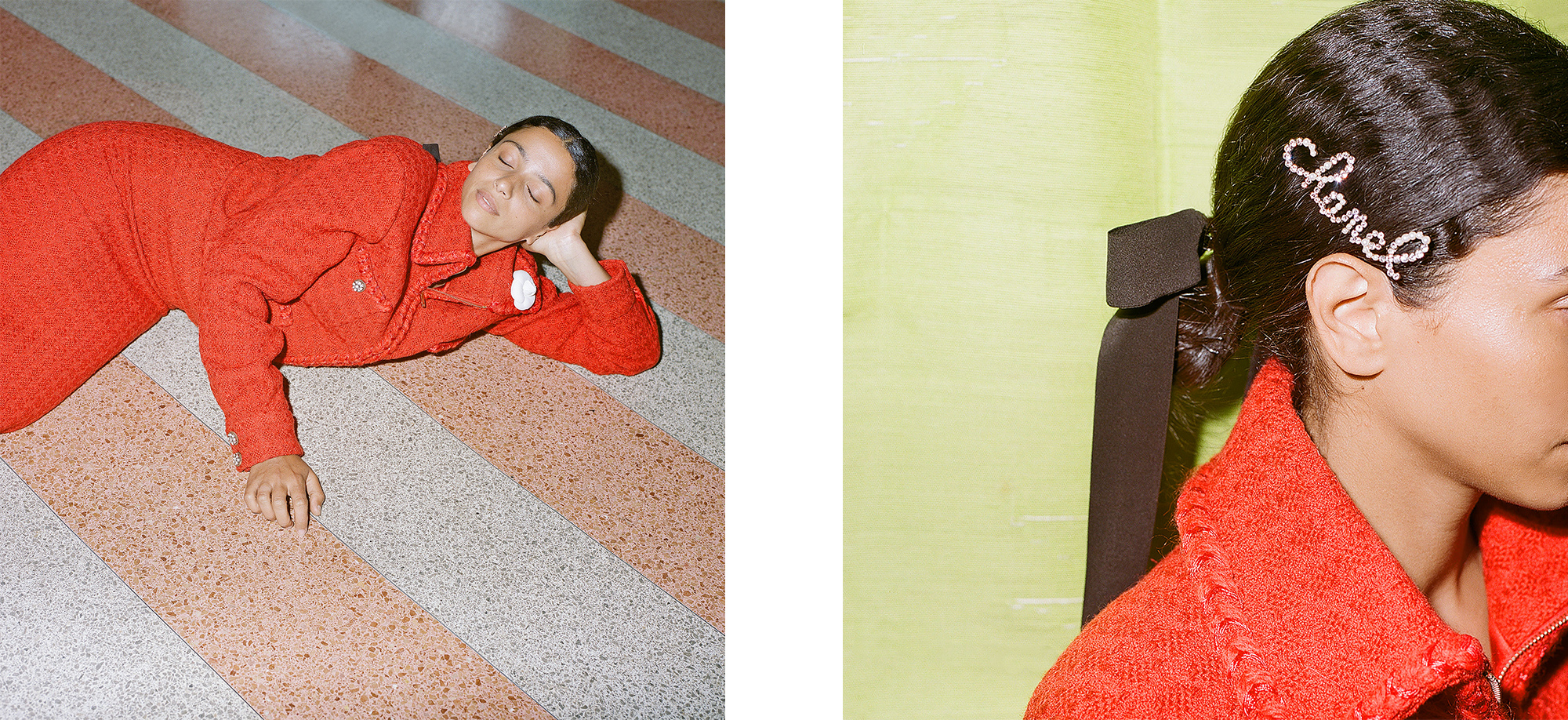A Beauty Less Ordinary:
Nadia Gohar
Finding a home in art.

Fendi dress; Ciao Lucia blouse; Bianca and Red bow clip; hose, stylist’s own; Hermès shoes; Van Cleef & Arpels Perlée collection jewellery including earrings, Perlée Couleurs long necklace, and rings; Blue Octopedi table made by Zachary Besner.
Growing up in Cairo, Nadia Gohar was fascinated by a giant ostrich egg. Painted cobalt blue, it was one of many strange objects that decorated her family home, and she remembers being captivated by its outsized proportions and peculiar beauty. The egg wasn’t particularly precious. Its place in the household hierarchy was in line with her childhood paintings and drawings, which were tacked up on the walls near it. Gohar treasured the egg all the same. Years later, now based in Toronto, she still finds herself charmed by the beauty of ordinary things.
I caught up with Gohar shortly after the end of her solo exhibition Mudstone, at Toronto’s Erin Stump Projects. We talked over FaceTime, the sound and picture quality cutting in and out intermittently in choppy waves. But this medium of interruptions turned out to be appropriate for where our conversation headed, as we talked about the feeling of existing in the liminal space between those unfixed places we call home and not-home.

HUGO coat; Christian Dior dress; Marc Cain handbag and scarf; Michons Marigot beret available at 100% Silk shop.
Gohar’s work in Mudstone continues a theme she first explored in Foundation Deposits at Soil Gallery in Seattle in 2018. That exhibition took as its starting point the practice of ancient Egyptian builders, who would bury auspicious objects in a structure’s foundation to safeguard its occupants. “I’m interested in how, in ancient cities, there are all these objects underground that we aren’t aware of,” she says. “And I’m always thinking about cases in museums: how things are displayed, why those things are chosen, what dictates that.” Who gets to decide which objects act as vessels of memory?
As an artist, Gohar’s art forms include painting and sculpture, as well as installation work. For Mudstone, she experimented with concrete—a much-maligned material ubiquitous in Cairo—dyeing it to resemble mud and using it to create casts of markers of cultural identity: a date stem, a palm-shaped incense bottle. Alongside, she scattered negative casts and imprints of these objects, as a way of physically representing the imperfect function of memory.

Chanel ensemble, camellia brooch, and hair accessories.

Gucci look; Rouge Dior Ultra Rouge Lipstick: 999 Ultra Dior, Iconic Red.
“My aesthetic is kind of scrappy, and I’m okay with that,” she says. “Wherever I am, I love to see where people get their keys made and what materials are used to cover buildings under construction.” Of course, she also appreciates fine craftsmanship. “There are certain things I love to see,” she says. Earlier this year, Gohar visited the Chanel ateliers in Paris and was struck by the way the petites mains at 31 rue Cambon do featherwork. “They’re not using feathers from rare birds anymore,” Gohar affirms. “Now it’s mostly chicken feathers.” The idea of creating magnificent boas out of something so mundane—by snipping, dyeing, and sewing them together just so—appealed to her. Peruse her Instagram (@nadia_gohar) and you’ll notice napkin art, sparkly hair clips, neatly made beds—all indicators of those small, everyday acts of care that elevate the commonplace.
It’s only since leaving Egypt that Gohar’s nostalgia for the place she left intensified. Is her work a way of satisfying that longing for a stable sense of home? “For sure. Yes,” she replies. In September she’ll visit the Middle East for a month-long residency at Darat al Funun, an art institute in Amman, Jordan, and then she’ll prepare for her February 2020 solo exhibition at the Opere Scelte gallery in Turin, Italy. “After that, I want to go back to school and do an MFA in sculpture,” she says. “I don’t know where.” 

HAiKw/ mesh jumpsuit; Bianca and Red bow clip; 100% Silk bandeau top; Giu Giu pants; Kaya Dua handbag; Josanna sandals; all available at 100% Silk shop.

Simone Rocha dress, barrette, and shoes; hose, stylist’s own; Number Sixteen scrunchie available at 100% Silk shop; Clash de Cartier jewellery, including rings and bracelet.

Michael Kors patchwork coat; Coach blouse; NorBlack NorWhite skirt; HAiKw/ bucket hat.
Shot on location at 100% Silk shop and The Drake Hotel. Makeup (using Dior) and Hair by Beauty by Nate. Art direction by Mark Reynolds. Maya Fuhr assisted by Chris Levett.
_________
Never miss a story. Sign up for NUVO’s weekly newsletter, here.




